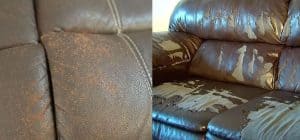Cats are known for their curious and sometimes mischievous behavior, and one common issue that many cat owners face is their feline friend scratching their leather furniture. It can be frustrating to see your beloved pet damaging your expensive pieces, but understanding why they do it is the first step to finding a solution.
So, why does my cat scratch leather?
Natural Instincts
Cats scratching on leather furniture is not just a random behavior – it’s ingrained in their natural instincts. By scratching, cats are not only stretching their muscles and keeping their claws in shape, but they are also marking their territory. Scratching helps them leave both a visual mark with the scratch marks and a scent mark from the glands in their paws. This territorial behavior is essential for cats in the wild, where marking their territory helps them communicate with other cats and establish their presence.
Texture Preference
You might wonder why your cat always chooses to scratch on your leather sofa instead of the scratching posts you bought. Well, it all comes down to their texture preference. Leather surfaces provide a satisfying sensation for cats due to the resistance it offers against their claws. The smooth yet durable texture of leather allows cats to fully extend their claws and get a good scratch. On the other hand, materials like carpet or cardboard may not provide the same resistance and satisfaction, making leather a preferred scratching surface for many feline friends.
Additional Tip:
To redirect your cat’s scratching behavior away from leather furniture, consider providing alternative scratching surfaces made of materials that mimic the texture of leather. Faux leather scratching posts or mats can be a great alternative that satisfies your cat’s need to scratch while protecting your furniture.
Stress and Anxiety
Cats can scratch leather furniture due to stress and anxiety. Just like humans, cats can feel overwhelmed or anxious in certain situations, leading them to exhibit unwanted behaviors like scratching. Providing your furry friend with a stress-free environment can help reduce their scratching tendencies. Ensure they have a quiet and safe space to retreat to when feeling anxious, and consider using pheromone diffusers or calming supplements to ease their stress levels.
Lack of Scratching Options
If your cat is scratching your leather furniture, it may be because they lack appropriate scratching posts and toys. Ensure your cat has a variety of scratching options available, such as vertical and horizontal scratching posts, cardboard scratchers, and interactive toys. Place these items strategically around your home to encourage your cat to use them instead of your furniture. Additionally, consider using catnip or treats to entice your cat to use their designated scratching areas.
Additional Unique Insight: Investing in a high-quality, sturdy scratching post made of materials like sisal or cardboard can greatly reduce your cat’s desire to scratch leather furniture. Cats prefer surfaces that allow them to stretch and flex their muscles while scratching, so providing them with a suitable scratching post can help redirect their behavior effectively. Also, regularly trim your cat’s nails to prevent damage to your furniture and encourage healthy scratching habits.
Remember, patience and consistency are key when helping your cat transition to appropriate scratching options. By addressing the root causes of their scratching behavior and providing them with suitable alternatives, you can protect your leather furniture while keeping your cat happy and healthy.
Behavioral Training
If your cat is scratching your leather items, there are a few behavioral training techniques you can try. First, provide alternative scratching surfaces like scratching posts. Next, use positive reinforcement by rewarding your cat when they scratch the appropriate surfaces. Additionally, try using deterrents like double-sided tape or citrus sprays on your leather items to discourage scratching. Consistency is key in training your cat, so be patient and persistent with these methods.
Seeking Veterinary Assistance If your cat’s scratching behavior persists despite trying behavioral training methods, it may be time to consult a veterinarian. A vet can help rule out any medical issues that could be causing the behavior. They can also provide further behavior modification strategies or recommend medication if necessary. Remember, your cat’s wellbeing is the top priority, so don’t hesitate to seek professional help if needed.
Extra tip: Regular nail trims for your cat can also help reduce scratching behavior since shorter nails are less damaging to your leather items.
Cat-Friendly Alternatives
If you’re wondering why your cat scratches your cherished leather furniture, fret not – there are cat-friendly alternatives to protect your pieces while keeping your feline friend satisfied. Consider investing in quality furniture covers specifically designed to withstand your cat’s scratching urges. Additionally, you can explore deterrent sprays that discourage your cat from targeting your leather items. These alternatives provide a win-win solution, ensuring your furniture remains intact while catering to your cat’s natural instincts.
Extra Tip: Introduce a scratching post or pad near your leather furniture to redirect your cat’s scratching behavior in a positive and rewarding way.
Fun Facts About Cat Behavior
Did you know that scratching is an essential behavior for cats to mark their territory? By leaving visible and olfactory marks through scratching, cats communicate their presence to other animals and establish a sense of ownership. This behavior is deeply ingrained in their nature and plays a vital role in their overall well-being. So, the next time you catch your cat scratching your leather items, remember it’s not just a random act – it’s their way of expressing themselves and claiming their space.
For more insights into cat behavior, you can explore informative resources like the American Association of Feline Practitioners (AAFP) website, which offers valuable tips on understanding and managing your cat’s scratching tendencies.
Alex, a passionate animal lover, has experience in training and understanding animal behavior. As a proud pet parent to two dogs and three cats, he founded AnimalReport.net to share insights from animal experts and expand his knowledge of the animal kingdom.









